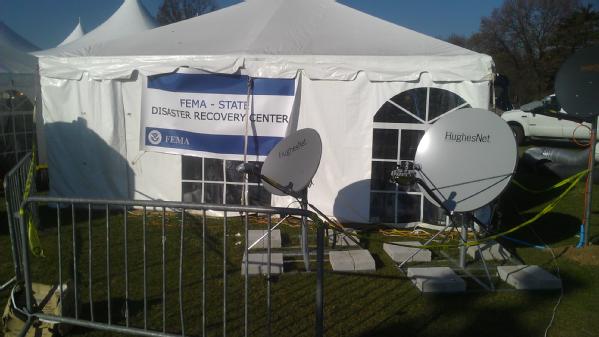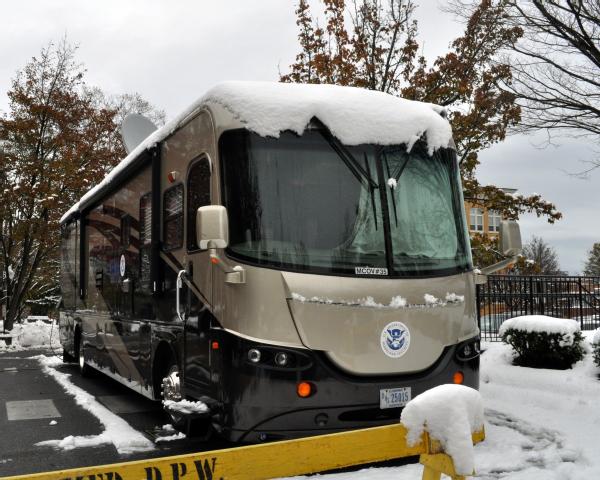When people think of innovation, they usually think that it is something for the tech or design world—they don’t associate it with government or bureaucracy. But, FEMA sees the role of innovation differently. We recognize the value of innovation—that through innovation we can develop new and creative solutions—and deliver these solutions to those that need them the most- survivors. We have been working on a number of fronts to incorporate innovation into our program and process. And during our ongoing response and recovery efforts in Hurricane Sandy, we have been taking our approach to innovation one step further.
Soon after Sandy made landfall, FEMA deployed an Innovation Team-- a multi-sector, cross functional group made up of people in government, non-profit and international organizations, volunteer groups, businesses, and concerned citizens: the whole community. At the most basic level, this team is all about creatively solving problems by receiving individual input from a diverse spectrum of stakeholders. They are about obtaining a perspective that is broader than just one sector, yet are agile and nimble enough to be a catalyst for real, impactful change to real world challenges. The team collides networks of people together and leverages the amazing resourcefulness of the many organizations that have an interest in serving individuals and communities impacted by disasters.
The Innovation Team is by no means FEMA’s first experience with innovation. We innovate on a regular basis, throughout our programs by valuing a forward leaning survivor centric approach to problem solving. However, it is the first time that an entire team was dedicated to developing solutions to real time problems.
In order to identify the real time challenges, the team co-located alongside FEMA employees in one of our disaster field offices in New York City. In doing so, they were able to work within FEMA and outside FEMA to identify challenges and fill gaps where necessary. There, they could tap into their networks, be a “fresh set of eyes”, and question underlying assumptions. The team is able to accomplish innovation in a number of ways: First and foremost, through always keeping the disaster survivor in mind when working towards and delivering solutions. Second, is by looking for ways to connect government with external groups. And third, is making time to talk regularly and brainstorming without restraint.
Providing internet connectivity in Red Hook
Hurricane Sandy affected hundreds of thousands of people in varying degrees- from leaving them with no electricity or running water, to damaging or even destroying their homes, to causing injuries. And with all of this devastation, there are many forms of assistance potentially available to help. It is our job to make sure that everyone affected by the storm knows about what assistance is available and how they can apply for that assistance. One way that we provide that information and assistance to survivors is by setting up disaster recovery centers in impacted locations—places where disaster survivors can talk face-to-face with staff from the state and FEMA about what assistance options are available. Soon after Hurricane Sandy made landfall, FEMA needed to set up over 40 of these disaster recovery centers in New York alone.
As is often the case, these disaster recovery centers are set up in neighborhoods hit hard by a disaster – and in Red Hook, New York, this was no exception. After the Innovation Team arrived at the center in Red Hook and spoke with the staff and disaster survivors, they realized there was a great need for internet connectivity. There were “hard lines” set up and a very weak Wi-Fi network—but this not enough. In this world of smartphones, tablets, and laptop computers—only having the options to sit at a hard lined computer is not going to fit the bill.
So the Innovation team sprang into action – they tapped into their network and linked up with IT volunteer organizations and highly skilled community volunteers. Within two days, not only had the Wi-Fi network area doubled, but it had also become accessible in a popular neighborhood courtyard and several of the surrounding buildings, providing hundreds of residents the ability to use the internet-- access information, check in with family and friends, and apply for disaster assistance online.
But we didn’t just make people come to us in Red Hook. We sent the internet to them. Teams from our Community Relations group were already going door-to-door in damaged neighborhoods, ensuring that word got out about the assistance that was available. We gave these teams iPads with internet connectivity—internet connectivity that came from a new satellite link up that the Innovation Team established. As a result, the internet was traveling door-to-door in neighborhoods throughout the city, allowing survivors to register for assistance from their own homes that were still without power, and allowing our teams to stay better informed of the changing needs on the ground.
This example of the Innovation Team’s work in Red Hook is just one story, one way we are trying to assist disaster survivors through the approach of connecting government with businesses and non-profit organizations. Why are we doing this? Because no one group has all the answers and FEMA is just one part of a large team. Government agencies need to tap into the vast amounts of knowledge and expertise that thrive outside our walls. And the same holds true for companies and volunteer-led groups. Government can be an invaluable partner; we have resources, networks, and experience that can contribute to solutions. The innovation team is one way for us to continue to partner with the whole community.
What we’ve learned so far
- The most valuable innovations often produce both tangible and intangible benefits:
While the Innovation Team was at Miller Park in Staten Island, NY they realized that there weren’t enough generators to provide service to the tents set up to provide assistance to disaster survivors. The dropping temperatures created a challenge in keeping the area heated. To solve this problem- the innovation team worked with local officials to move a spare generator onto the hitch of a FEMA truck and bring it to the site. With the additional generator, both tents warmed up and the survivors were served that evening in comfort and security.



Much of the way the Innovation Team adds value is through localized solutions like these– where they look at a situation objectively, identify a problem, suggest a solution, and contribute to its success. In this case, the team worked across organizational boundaries for electrical power, light, tents, communications, transportation, and different levels of government. Ultimately, their work helped keep disaster survivors warm – people who were already under a great deal of stress.
- Innovations that come with cost savings can be doubly sweet.
Setting up a disaster recovery center or an office in the field requires a basic level of telecommunications. At the very least, the site should have telephone, power, and, ideally, internet. This can be a tall order in areas with little to no infrastructure remaining after an emergency. In some cases, FEMA will bring vehicles or equipment, such as a Mobile Communications Operations Vehicle or MCOV, to establish the basic level of communications needed to provide assistance.

These vehicles help FEMA and our partners operate in areas with telecommunications in areas we otherwise may not be able to, which is a great thing. But these vehicles are a scarce resource, and after an event like Hurricane Sandy, they are in high demand in many locations that need help to get up and running. And one of these locations was the Rockaways.
As FEMA staff and the Innovation Team worked to set up a disaster recovery center in a Rockaways neighborhood, they needed an MCOV in the area to support the limited telecommunications infrastructure. However, instead of increasing demand on the limited supply—they developed an alternate solution. The team, through a combination of government, industry, academia and volunteer sources, set up equipment and services to create a communication network capable of supporting FEMA’s mission. Ultimately, they used an existing internet connection to enhance connectivity, allowing an MCOV to be used elsewhere.
The model of connecting government with outside networks has been around for a long time, but FEMA is putting a new spin on it through the Innovation Team. The work done before, during, and after Hurricane Sandy has inspired several new partnerships. FEMA is now assessing the lessons from Hurricane Sandy and evaluating new potential projects.
These past success stories and ongoing projects will only continue to be successful if we take the lessons learned from the Innovation Team and Hurricane Sandy and continue to focus on delivering solutions to disaster survivors. We need to keep collaborating—bringing groups together, challenging our commonly held perceptions, and relentlessly pursuing solutions that can offer a much needed ray of hope to those in need.
FEMA will continue this conversation during our next FEMA Think Tank Conference Call being held at the White House on February 6, 2013. This call is open to the public – it is a forum to bring the whole community into this conversation about incorporating innovation into emergency management. To learn more about the FEMA Think Tank and get information on the call, please visit www.fema.gov/thinktank.


Add new comment